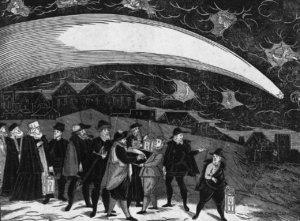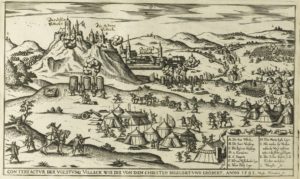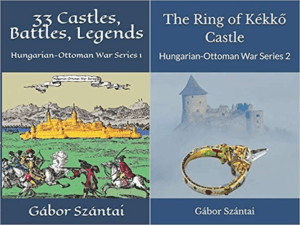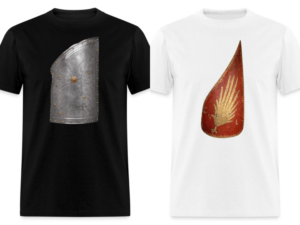Szikszó

The city of Szikszó is a market town in Borsod County, Hungary. It is only 17 kilometers east of Miskolc. The first mention of the settlement is from 1280 when King László IV issued three documents from there. The next king to visit the place and issue a document was King Károly Róbert in 1307. At that time the area belonged to the Aba family. King Zsigmond inherited it from them in 1391. He gave it to his wife, Queen Mária, as well as the castle of Diósgyőr. Szikszó was considered a “royal” town, which meant that it enjoyed various freedoms and privileges.

The Gothic church, with its 170 centimeter thick stone walls, was built during the town’s heyday. Stones from previous churches were used in the construction of the new church, although the vaulted roof was not completed until 1500. In the northern part of the church, we can see a stone commemorating the victory of 1588 when Count Rákóczi Zsigmond, later Prince of Transylvania, defeated the Turks at Szikszó. (Please note that I use the oriental name order for Hungarians, where the surname comes first).

At the end of the 16th century, the settlement was surrounded by an earthen wall with five bastions at each corner of the pentangular structure. Szikszó was part of the chain of castles of the Hungarian borderland against the Ottoman Empire. Szikszó developed rapidly due to its location on the trade route between Kassa (Kosice, Kaschau) and Krakow. The wine production in the area was considerable. The lords of the town came from the Perényi family and the inhabitants converted to Protestantism in the 16th century, taking over the Gothic church for the Reformed faith.

As long as Szikszó was on the Borderland, it officially belonged to the Kingdom of Hungary. However, the Pasha of Buda often forced the town to pay taxes to the Ottoman Empire. When the taxes did not arrive in Buda, the Ottoman troops would appear in Szikszó. The first major conflict took place on 13 October 1558, when Bey Velican of Fülek Castle looted and burned the town.
When Velican was on his way home with his booty, Bebek György, and Telekessy Imre ambushed him at the Sajó River and defeated his army. Although we know that the town began to pay its taxes to the Turks more regularly in 1564, the Ottoman threat did not cease. In 1566 and 1567, as well as in 1573 and 1577, there were Turkish sackings. On these occasions, the inhabitants took refuge behind the wall of the church and shot at the enemy from its tower.

The Second Battle of Szikszó on 10 November 1577
The Ottomans were determined to get their hands on the wealthy market town of Szikszó. The second major clash took place on 10 November 1577, when Bey Ferhát of Fülek Castle attacked the town in the middle of the Sunday morning service, interrupting the Reformed pastor’s sermon. Ferhát was a Hungarian renegade and he was well aware of the importance of the St. Martin’s Day Fair. So he timed his surprise attack to coincide with this famous town fair, which attracted traders from all over the country. The attackers (1,200 infantrymen and 800 cavalrymen) traveled at night to get there unnoticed and surrounded the town at dawn.

They managed to break through the church’s low stone fence, slaughtering 27 townspeople on the spot and wounding many more in the graveyard around the church. The Protestants, however, stubbornly held the large Gothic church building. They shot many of the attackers from the tower, including the noble-born Turkish warrior Deli Deberhan. From this, we can conclude that the Hungarians either visited the church with their weapons or there must have been an armory in the church. The fighting and plundering went on all day and did not end until late at night when the sky was lit by the famous comet of 1577.

The Turks took more than 200 captives (other sources say 1,000), many of them noble ladies and wealthy merchants. They were unable to return home quickly because of all the booty, so they had to spend the night in a nearby village. When Bey Ferhát returned home the next day, he was beaten again in the same place as years before, at the ford of the Sajó River near Sajószentpéter or Vadna.
Prépostváry had left Kassa when he received the news, with his Hussars and the yellow-uniformed German horsemen and infantrymen, less than 400 men in all. They set a trap for the Turks, who were on their way home, and waited for them in full armor and readiness for half a day. Prépostváry even sent two hussars to lure them.

Finally, the Ottomans, loaded with booty, appeared at the village of Kasza at 4 p.m. and, seeing the two hussars, began to chase them. The Hungarian horsemen (the so-called ” bait “) led them to the place where the rest of the Hungarians and Germans were hiding. Although the Ottomans had many more soldiers, the Hungarians defeated the Borderland Warriors of Szendrő Castle, led by Captain Claudius Roussel and Captain Rákóczi Zsigmond, and the hussars of Geszti Ferenc and Prépostváry Bálint from Kassa by the evening.

While only three hussars of Prépostváry’s unit were lost, they killed 400 or 500 Ottoman warriors and captured 250 soldiers, among them four officers: Hussein “Alajbey”, who was wounded in the head and hand, two Aghas, and the officer of the Pasha of Buda. The Hungarians lost 14 horses and 20 others were wounded. At the same time, they captured 600 Ottoman horses.
The hussars of Szendrő did not lose a single horse and the German horsemen in yellow jackets had only one dead. We know that the local Hungarian peasants joined in the slaughter, killing many of the Ottoman captives and robbing and hiding many booties. (It is assumed that the Turks had looted them beforehand).

The Bey of Fülek was badly wounded but managed to escape with the help of a Hungarian renegade “pribék” called Csákány Kelemen, the guide of the Turks. He took the Bey to the castle of Ajnácskő, where his wounds were treated. The Hungarians won seven flags and several light cannons. They were able to free almost all the captured noblewomen. It is said that more than 1,000 prisoners (not counting those tied to carts) were rescued from the slave market. The hussars hunted the enemy until midnight, under the light of the comet.

According to the judge of Rimaszombat, who happened to be at Fülek Castle when the Bey of Fülek returned with his eleven horsemen after 11 November, he witnessed the following: the Bey asked the guards at the gate how many other Turks had returned from the battle. They replied that none had returned. When the Bey heard this, he ran into his room, threw himself on the floor, and began to weep bitterly. He did not want to see anyone for three days.

In addition to the Ottomans’ plight, the Hussars of Eger appeared and killed another 400 of the fleeing enemy. According to the Venetian envoy, everyone in Vienna was praising the Hungarians’ success. In 1586, the people of Szikszó built a palisade with a moat around their town to protect it from plundering marauders and the Turks, at the same time transforming the old church into a heavily fortified building.

Further Ottoman attacks
The Ottomans did not learn from their previous defeats and tried again and again to take Szikszó. The third and biggest battle of Szikszó took place in 1588, when an Ottoman army of 11,000 men attacked the town, more than ever before. However, Captain Rákóczi Zsigmond of Eger Castle defeated them with his 2,000 hussars and 400-500 German infantrymen. Several hundred Hungarian and German soldiers died in this battle, while the Turks lost more than 2,000 men. You can read the detailed description of this battle in my book “33 Castles, Battles, Legends”.
The attack in 1592
As we have seen, in 1558, 1577, and 1588, thousands of Turkish troops attacked the city, but were defeated on all three occasions. Unfortunately, the Ottomans defeated the Eger warriors at Szikszó in the summer of 1592.
The Ottoman warriors from the Sandjak centers of Gyula, Jenő, Hatvan, Fülek, and Szolnok joined forces and attacked Szikszó to avenge the previous defeats. We have a detailed source of the battle from the letter of Captain Prépostváry Bálint of Eger Castle, his relative. In short, we can say that he wrote that the Ottoman cavalry outnumbered the hussars, who quickly turned and fled. Many Hungarian officers were captured and some hussars died. Here is his full letter:
“Your Grace would like to understand the case of Balázsdeák István and Segnyey Miklós: Balázsdeák István is with the Bey of Jenő, he is not ill, it is rumored that they want to take him to the Sublime Porte. But the servants of my lord Rákóczi have caught a young man, whom I also had six servants to capture; some say that he is none other than the Bey of Jenő Castle, who, if he were the same, would be the son of the Pasha of Buda, for the son of the Pasha of Buda was slain, and the Bey of Jenő is his son; if so, this young man would not only free Balázsdeák István, but others as well.
Segnyey Miklós is wounded, but he is recovering; he is with the Bey of Gyula. I have begun to take steps for their release. Besides them, Zay András and Bory Pál were captured; they are with the Pasha of Buda. There are no more than four of these officers lost, and the priest is the fifth; besides these two poor men, there are three or three knights, and men on horseback, and horsemen; the poor infantry are all lost. They had stood on a hill, and they had fought long for it; they (the Turks) had taken it from them; they went to another hill, and they would not give it up until death;
They shot many Turks, while they had gunpowder and bullets; finally, they were put to the sword; the Turks asked them to surrender, but they did not, but the Turks brought the cannons (with grapeshots) and the taracks. The whole (Turkish) army, all the soldiers and footmen, besieged the hill with a great siege, and so the poor men were slaughtered. In summary, when I had buried them all, I gathered them all together and buried two hundred and twenty-six bodies of all those who had perished in the battle.
The triumph is the pagans’, but even the heathen mourn, many of them have fallen, the only son of the Pasha of Sasvár also died, whose head is in the gate here.”

A Hungarian Hajdú infantryman
Among the prisoners was Zay András, who was released in the autumn of the same year. But Balázsdeák, a famous officer, had to spend five years in prison. With the help of Pálffy Miklós, he was exchanged for Hassan, the Bey of Koppány in 1597. A priest named Hetei Pál was also captured.

Further struggles in the Early Modern Age
The next battle of Szikszó took place in 1679 when Prince Thököly Imre of Transylvania was victorious over the imperial troops of the Habsburgs.
The citizens of Szikszó joined the War of Independence of Prince Rákóczi Ferenc II in 1703. Three years later, General Rabutin set the whole town on fire in revenge. After another big fire in 1852, the town declined and became a rather large village. However, if you ask the people of Szikszó, they can show you the place called “Törökhalom” (Turkish Pile), where the fallen soldiers of the famous battle of 1588 sleep together in their mass grave, Hungarians and Turks side by side with Germans.

Sources: Szibler Gábor, Szerecz Miklós, Takáts Sándor and Csiffáry Gergely: Az egri végváriak tevékenysége 1548-1596 között. In: Veres Gábor (szerk.): Agria. Az egri Dobó István Vármúzeum Évkönyve. XLVI. Eger, 2010.
Dear Readers, I can only make this content available through small donations or by selling my books or T-shirts:
Please, feel free to support me with a coffee here:
You can check out my books on Amazon or Draft2Digital, they are available in hardcover, paperback, or ebook:
https://www.amazon.com/dp/198020490X or at https://books2read.com/b/boYd81

My work can also be followed and supported on Patreon: Become a Patron!http://Become a Patron!
[wpedon id=”9140″]

https://hungarianottomanwars.myspreadshop.com/all












